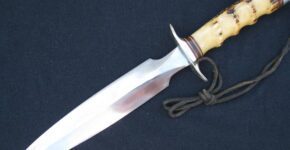

Last summer I wrote a piece on provenance which I think is a huge part of the collecting hobby, and I want to revisit the subject for a couple of reasons. One, is because it is so important on several fronts to establish and maintain the history of a knife. Secondly, because there has been the opportunity of late for collectors to acquire some great pieces from auction sites, as well as some great items coming on the market from collectors and purveyors.
You will note from the title of this article that beyond a great item which may have many attractive elements that prods us into adding a Randall to our collection, the lone element that can put a piece over the top is a history of the knife. For some this is a purely intrinsic value, but it also can point to the first intent Bo Randall had when he decided to become a cutler, and that is to provide the outdoorsman and serviceman a great value for a durable tool with a well thought out design that will last a lifetime and beyond. I think it is safe to say that while William Scagel may be the grandfather of modern knife making, Bo Randall is the father of modern knife design, and it is these designs that help set Randall Made apart from others. Randall Made Knives have never been “cheap” relative to machine fabricated and even some hand made pieces, but therein lays the allure. You get what you pay for.
Beyond the known advantages of provenance on a wartime carried piece, or the maybe one that was on an expedition down the Amazon in the 1950’s, is the added benefit of giving us a window into the past of Randall Made Knives, when it was made, and how the knife was put together during a certain period. This historical perspective if sought after and kept by collectors aids us in this constant drive to “date” Randall knives, and to catalogue characteristics.
Sometimes it can take some work to eek out a very little provenance, and other times it can be a flood of information without breaking a sweat. In either case, lending to the history is paramount, and no contribution is too small. This is evidenced by how much was devoted to the subject in Bob Hunt’s books, to offer a bit of a story with many of the knives pictured, but also to devote one book almost solely to the subject of supporting provenance. That says allot.
So the importance of provenance can not be argued, and the various types an owner would make an effort to acquire runs the gamut from order/shipping documents, military records, photographs, and owner/family history. As time marches on, we often see knives become available from a relative of one who has passed, and unless the savvy collector looks beyond the excitement of acquiring the new piece and neglects even an attempt to get some historical information, it is lost forever. That knife then becomes an example from a period, and while helping with the timeline because of its similarities to documented examples, it falls a bit short in contributing to the pool of information.
Aside from giving “life to the knife”, a bonus often benefiting the collector is he is very often rewarded with an increase in additional monetary value for his efforts. While we may discount value to some degree as purists, I believe most will acknowledge value is still much a part of the hobby. Sometimes the provenance alone has substantial value. I hope this added benefit will encourge more to go the extra mile to obtain historical information on a new purchase or trade, or even knives already in their collection. I also hope that while on the journey we as collectors understand the importance of obtaining as much information as possible when acquiring a vintage Randall Made Knife.